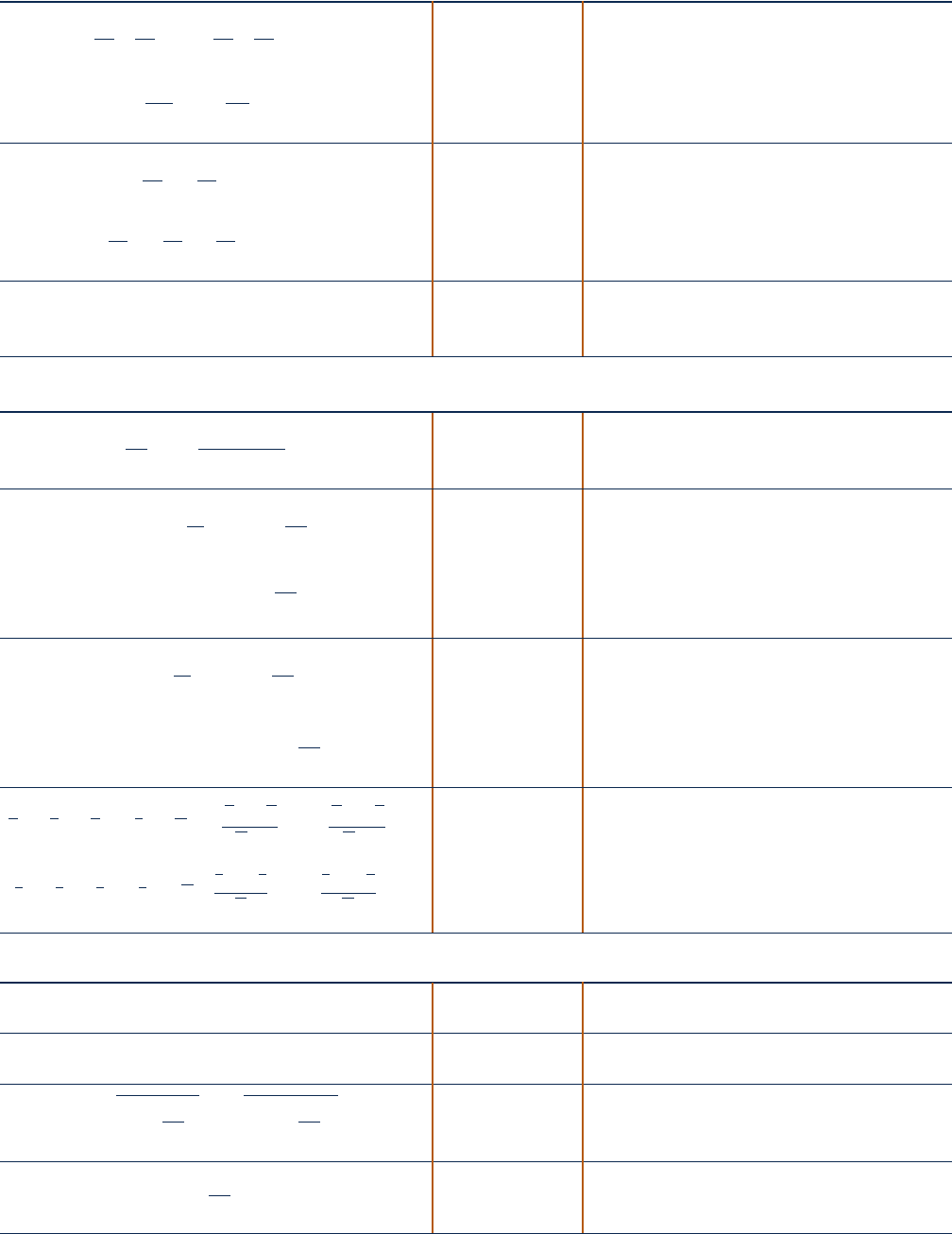Moran M.J., Shapiro H.N. Fundamentals of Engineering Thermodynamics
Подождите немного. Документ загружается.


Expressions for the internal energy, enthalpy, and Helmholtz function can be obtained from
Eq. 11.108, using the definitions H 5 U 1 pV, G 5 H 2 TS, and C 5 U 2 TS. They are
U 5 TS 2 pV 1
a
j
i51
n
i
m
i
H 5 TS 1
a
j
i51
n
i
m
i
(11.109)
° 52pV 1
a
j
i51
n
i
m
i
Other useful relations can be obtained as well. Forming the differential of
G(T, p, n
1
, n
2
, . . . , n
j
)
dG 5
0G
0p
b
T, n
dp 1
0G
0T
b
p, n
dT 1
a
j
i51
a
0G
0n
i
b
T, p, n
l
dn
i
(11.110)
The subscripts n in the first two terms indicate that all n’s are held fixed during dif-
ferentiation. Since this implies fixed composition, it follows from Eqs. 11.30 and 11.31
(Sec. 11.3.2) that
V 5 a
0G
0p
b
T, n
and
2S 5 a
0G
0T
b
p, n
(11.111)
With Eqs. 11.107 and 11.111, Eq. 11.110 becomes
dG 5 V dp 2 S dT 1
a
j
i
51
m
i
dn
i
(11.112)
which for a multicomponent system is the counterpart of Eq. 11.23.
Another expression for dG is obtained by forming the differential of Eq. 11.108.
That is
dG 5
a
j
i51
n
i
dm
i
1
a
j
i51
m
i
dn
i
Combining this equation with Eq. 11.112 gives the Gibbs–Duhem equation
a
j
i51
n
i
dm
i
5 V dp 2 S dT
(11.113)
11.9.3
Fundamental Thermodynamic Functions for
Multicomponent Systems
A fundamental thermodynamic function provides a complete description of the ther-
modynamic state of a system. In principle, all properties of interest can be determined
from such a function by differentiation and/or combination. Reviewing the develop-
ments of Sec. 11.9.2, we see that a function G(T, p, n
1
, n
2
, . . . , n
j
) is a fundamental
thermodynamic function for a multicomponent system.
Functions of the form U(S, V, n
1
, n
2
, . . . , n
j
), H(S, p, n
1
, n
2
, . . . , n
j
), and C(T, V,
n
1
, n
2
, . . . , n
j
) also can serve as fundamental thermodynamic functions for multicomponent
systems. To demonstrate this, first form the differential of each of Eqs. 11.109 and use the
Gibbs–Duhem equation, Eq. 11.113, to reduce the resultant expressions to obtain
dU 5 T dS 2 p dV 1
a
j
i51
m
i
dn
i
(11.114a)
dH 5 T dS 1 V dp 1
a
j
i51
m
i
dn
i
(11.114b)
d° 52p dV 2 S dT 1
a
j
i51
m
i
dn
i
(11.114c)
Gibbs–Duhem equation
11.9 Analyzing Multicomponent Systems 683
c11ThermodynamicRelations.indd Page 683 7/23/10 6:25:35 PM user-s146 c11ThermodynamicRelations.indd Page 683 7/23/10 6:25:35 PM user-s146 /Users/user-s146/Desktop/Merry_X-Mas/New/Users/user-s146/Desktop/Merry_X-Mas/New

684 Chapter 11
Thermodynamic Relations
For multicomponent systems, these are the counterparts of Eqs. 11.18, 11.19, and 11.22,
respectively.
The differential of U(S, V, n
1
, n
2
, . . . , n
j
) is
dU 5
0U
0S
b
V, n
dS 1
0U
0V
b
S, n
dV 1
a
j
i51
a
0U
0n
i
b
S,V, n
l
dn
i
Comparing this expression term by term with Eq. 11.114a, we have
T 5
0U
0S
b
V, n
,
2p 5
0U
0V
b
S, n
,
m
i
5
0U
0n
i
b
S,V, n
l
(11.115a)
That is, the temperature, pressure, and chemical potentials can be obtained by dif-
ferentiation of U(S, V, n
1
, n
2
, . . . , n
j
). The first two of Eqs. 11.115a are the counterparts
of Eqs. 11.24 and 11.25.
A similar procedure using a function of the form H(S, p, n
1
, n
2
, . . . , n
j
) together
with Eq. 11.114b gives
T 5
0H
0S
b
p, n
,
V 5
0H
0p
b
S, n
,
m
i
5
0H
0n
i
b
S, p, n
l
(11.115b)
where the first two of these are the counterparts of Eqs. 11.26 and 11.27. Finally, with
C(S, V, n
1
, n
2
, . . . , n
j
) and Eq. 11.114c
2p 5
0°
0V
b
T, n
,
2S 5
0°
0T
b
V, n
,
m
i
5
0°
0n
i
b
T,V, n
l
(11.115c)
The first two of these are the counterparts of Eqs. 11.28 and 11.29. With each choice
of fundamental function, the remaining extensive properties can be found by combi-
nation using the definitions H 5 U 1 pV, G 5 H 2 TS, C = U 2 TS.
The foregoing discussion of fundamental thermodynamic functions has led to sev-
eral property relations for multicomponent systems that correspond to relations
obtained previously. In addition, counterparts of the Maxwell relations can be obtained
by equating mixed second partial derivatives. For example, the first two terms on the
right of Eq. 11.112 give
0V
0T
b
p, n
52
0S
0p
b
T, n
(11.116)
which corresponds to Eq. 11.35. Numerous relationships involving chemical potentials
can be derived similarly by equating mixed second partial derivatives. An important
example from Eq. 11.112 is
0m
i
0p
b
T, n
5
0
V
0n
i
b
T, p, n
l
Recognizing the right side of this equation as the partial molal volume, we have
0m
i
0p
b
T, n
5 V
i
(11.117)
This relationship is applied in the development of Eqs. 11.126.
The present discussion concludes by listing four different expressions derived
above for the chemical potential in terms of other properties. In the order obtained,
they are
m
i
5
0G
0n
i
b
T, p, n
l
5
0
U
0n
i
b
S, V, n
l
5
0
H
0n
i
b
S, p, n
l
5
0
°
0n
i
b
T, V, n
l
(11.118)
Only the first of these partial derivatives is a partial molal property, however, for
the term partial molal applies only to partial derivatives where the independent
c11ThermodynamicRelations.indd Page 684 6/21/10 9:36:32 PM user-s146 c11ThermodynamicRelations.indd Page 684 6/21/10 9:36:32 PM user-s146 /Users/user-s146/Desktop/Merry_X-Mas/New/Users/user-s146/Desktop/Merry_X-Mas/New

variables are temperature, pressure, and the number of moles of each component
present.
11.9.4
Fugacity
The chemical potential plays an important role in describing multicomponent systems.
In some instances, however, it is more convenient to work in terms of a related prop-
erty, the fugacity. The fugacity is introduced in the present discussion.
Single-Component Systems
Let us begin by taking up the case of a system consisting of a single component. For
this case, Eq. 11.108 reduces to give
G 5 nm
or
m 5
G
n
5 g
That is, for a pure component the chemical potential equals the Gibbs function per
mole. With this equation, Eq. 11.30 written on a per mole basis becomes
0
m
0p
b
T
5 y
(11.119)
For the special case of an ideal gas, y 5 RT
/
p, and Eq. 11.119 assumes the form
0m
*
0p
b
T
5
RT
p
where the asterisk denotes ideal gas. Integrating at constant temperature
m
*
5 RT ln p 1 C 1T2 (11.120)
where C(T) is a function of integration. Since the pressure p can take on values from
zero to plus infinity, the ln p term of this expression, and thus the chemical potential,
has an inconvenient range of values from minus infinity to plus infinity. Equation
11.120 also shows that the chemical potential can be determined only to within an
arbitrary constant.
INTRODUCING FUGACITY. Because of the above considerations, it is advanta-
geous for many types of thermodynamic analyses to use fugacity in place of the
chemical potential, for it is a well-behaved function that can be more conveniently
evaluated. We introduce the fugacity f by the expression
m 5 RT ln f 1 C1T2 (11.121)
Comparing Eq. 11.121 with Eq. 11.120, the fugacity is seen to play the same role in
the general case as pressure plays in the ideal gas case. Fugacity has the same units
as pressure.
Substituting Eq. 11.121 into Eq. 11.119 gives
RT a
0 ln
f
0p
b
T
5 y
(11.122)
Integration of Eq. 11.122 while holding temperature constant can determine the fugac-
ity only to within a constant term. However, since ideal gas behavior is approached as
pressure tends to zero, the constant term can be fixed by requiring that the fugacity of
a pure component equals the pressure in the limit of zero pressure. That is
lim
pS 0
f
p
5 1
(11.123)
Equations 11.122 and 11.123 then completely determine the fugacity function.
fugacity
11.9 Analyzing Multicomponent Systems 685
c11ThermodynamicRelations.indd Page 685 6/21/10 9:36:34 PM user-s146 c11ThermodynamicRelations.indd Page 685 6/21/10 9:36:34 PM user-s146 /Users/user-s146/Desktop/Merry_X-Mas/New/Users/user-s146/Desktop/Merry_X-Mas/New

686 Chapter 11
Thermodynamic Relations
EVALUATING FUGACITY. Let us consider next how the fugacity can be evalu-
ated. With Z 5 py
/
RT, Eq. 11.122 becomes
RT a
0 ln
f
0p
b
T
5
RTZ
p
or
a
0
ln f
0p
b
T
5
Z
p
Subtracting 1/p from both sides and integrating from pressure p9 to pressure p at fixed
temperature T
3ln f 2 ln p4
p
p¿
5
#
p
p¿
1Z 2 12d ln p
or
cln
f
p
d
p
p¿
5
#
p
p¿
1Z 2 12d ln p
Taking the limit as p9 tends to zero and applying Eq. 11.123 results in
ln
f
p
5
#
p
0
1Z 2 12d ln p
When expressed in terms of the reduced pressure, p
R
5 p/p
c
, the above equation is
ln
f
p
5
#
p
R
0
1Z 2 12d ln p
R
(11.124)
Since the compressibility factor Z depends on the reduced temperature T
R
and reduced
pressure p
R
, it follows that the right side of Eq. 11.124 depends on these properties only.
Accordingly, the quantity ln f/p is a function only of these two reduced properties. Using
a generalized equation of state giving Z as a function of T
R
and p
R
, ln f/p can readily
be evaluated with a computer. Tabular representations are also found in the literature.
Alternatively, the graphical representation presented in Fig. A-6 can be employed.
to illustrate the use of Fig. A-6, consider two states of water
vapor at the same temperature, 4008C. At state 1 the pressure is 200 bar, and at state
2 the pressure is 240 bar. The change in the chemical potential between these states
can be determined using Eq. 11.121 as
m
2
2 m
1
5 RT ln
f
2
f
1
5 RT ln a
f
2
p
2
p
2
p
1
p
1
f
1
b
Using the critical temperature and pressure of water from Table A-1, at state 1 p
R1
5 0.91,
T
R1
5 1.04, and at state 2 p
R2
5 1.09, T
R2
5 1.04. By inspection of Fig. A-6, f
1
/p
1
5 0.755
and f
2
/p
2
5 0.7. Inserting values in the above equation
m
2
2 m
1
5 18.31421673.152 ln c10.72a
240
200
ba
1
0.755
bd5 597 kJ
/
kmol
For a pure component, the chemical potential equals the Gibbs function per mole,
g 5 h 2 T s. Since the temperature is the same at states 1 and 2, the change in the
chemical potential can be expressed as m
2
2 m
1
5 h
2
2 h
1
2 T1
s
2
2 s
1
2. Using steam
table data, the value obtained with this expression is 597 kJ/kmol, which agrees with
the value determined from the generalized fugacity coefficient chart. b b b b b
Multicomponent Systems
The fugacity of a component i in a mixture can be defined by a procedure that par-
allels the definition for a pure component. For a pure component, the development
c11ThermodynamicRelations.indd686 Page 686 6/21/10 9:37:12 PM user-s146 c11ThermodynamicRelations.indd686 Page 686 6/21/10 9:37:12 PM user-s146 /Users/user-s146/Desktop/Merry_X-Mas/New/Users/user-s146/Desktop/Merry_X-Mas/New

begins with Eq. 11.119, and the fugacity is introduced by Eq. 11.121. These are then
used to write the pair of equations, Eqs. 11.122 and 11.123, from which the fugacity
can be evaluated. For a mixture, the development begins with Eq. 11.117, the coun-
terpart of Eq. 11.119, and the fugacity f
i
of component i is introduced by
m
i
5 RT ln f
i
1 C
i
1T2 (11.125)
which parallels Eq. 11.121. The pair of equations that allow the fugacity of a mixture
component
, f
i
, to be evaluated are
RT a
0 ln
f
i
0p
b
T, n
5 V
i
(11.126a)
lim
pS 0
a
f
i
y
i
p
b5 1
(11.126b)
The symbol
f
i
denotes the fugacity of component i in the mixture and should be care-
fully distinguished in the presentation to follow from f
i
, which denotes the fugacity of
pure i.
DISCUSSION. Referring to Eq. 11.126b, note that in the ideal gas limit the fugac-
ity f
i
is not required to equal the pressure p as for the case of a pure component, but
to equal the quantity y
i
p. To see that this is the appropriate limiting quantity, consider
a system consisting of a mixture of gases occupying a volume V at pressure p and
temperature T. If the overall mixture behaves as an ideal gas, we can write
p 5
nRT
V
(11.127)
where n is the total number of moles of mixture. Recalling from Sec. 3.12.3 that an
ideal gas can be regarded as composed of molecules that exert negligible forces on
one another and whose volume is negligible relative to the total volume, we can think
of each component i as behaving as if it were an ideal gas alone at the temperature
T and volume V. Thus, the pressure exerted by component i would not be the mixture
pressure p but the pressure p
i
given by
p
i
5
n
i
RT
V
(11.128)
where n
i
is the number of moles of component i. Dividing Eq. 11.128 by Eq. 11.127
p
i
p
5
n
i
RT
/
V
n
RT
/
V
5
n
i
n
5 y
i
On rearrangement
p
i
5 y
i
p (11.129)
Accordingly, the quantity y
i
p appearing in Eq. 11.126b corresponds to the pressure p
i
.
Summing both sides of Eq. 11.129, we obtain
a
j
i51
p
i
5
a
j
i51
y
i
p 5 p
a
j
i51
y
i
Or, since the sum of the mole fractions equals unity
p 5
a
j
i51
p
i
(11.130)
In words, Eq. 11.130 states that the sum of the pressures p
i
equals the mixture pres-
sure. This gives rise to the designation partial pressure for p
i
. With this background,
we now see that Eq. 11.126b requires the fugacity of component i to approach the
partial pressure of component i as pressure p tends to zero. Comparing Eqs. 11.130
fugacity of a mixture
component
11.9 Analyzing Multicomponent Systems 687
c11ThermodynamicRelations.indd687 Page 687 6/21/10 9:37:15 PM user-s146 c11ThermodynamicRelations.indd687 Page 687 6/21/10 9:37:15 PM user-s146 /Users/user-s146/Desktop/Merry_X-Mas/New/Users/user-s146/Desktop/Merry_X-Mas/New

688 Chapter 11
Thermodynamic Relations
and 11.99a, we also see that the additive pressure rule is exact for ideal gas mixtures.
This special case is considered further in Sec. 12.2 under the heading Dalton model.
EVALUATING FUGACITY IN A MIXTURE. Let us consider next how the
fugacity of component i in a mixture can be expressed in terms of quantities that can
be evaluated. For a pure component i, Eq. 11.122 gives
RT a
0 ln
f
i
0p
b
T
5 y
i
(11.131)
where y
i
is the molar specific volume of pure i. Subtracting Eq. 11.131 from Eq.
11.126a
RT c
0 ln 1
f
i
/
f
i
2
0p
d
T, n
5 V
i
2 y
i
(11.132)
Integrating from pressure p9 to pressure p at fixed temperature and mixture compo-
sition
RT clna
f
i
f
i
bd
p
p¿
5
#
p
p¿
1V
i
2 y
i
2
dp
In the limit as p9 tends to zero, this becomes
RT cln a
f
i
f
i
b2 lim
p¿S0
ln a
f
i
f
i
bd5
#
p
0
1V
i
2 y
i
2
dp
Since f
i
S p¿ and f
i
S y
i
p¿ as pressure p9 tends to zero
lim
p¿S0
ln a
f
i
f
i
bS ln a
y
i
p¿
p¿
b5 ln y
i
Therefore, we can write
RT cln a
f
i
f
i
b2 ln y
i
d5
#
p
0
1V
i
2 y
i
2
dp
or
RT ln a
f
i
y
i
f
i
b5
#
p
0
1V
i
2 y
i
2
dp
(11.133)
in which f
i
is the fugacity of component i at pressure p in a mixture of given com-
position at a given temperature, and f
i
is the fugacity of pure i at the same tempera-
ture and pressure. Equation 11.133 expresses the relation between f
i
and f
i
in terms
of the difference between V
i
and y
i
, a measurable quantity.
11.9.5
Ideal Solution
The task of evaluating the fugacities of the components in a mixture is considerably
simplified when the mixture can be modeled as an ideal solution. An ideal solution is
a mixture for which
f
i
5 y
i
f
i
1ideal solution2 (11.134)
Equation 11.134, known as the Lewis–Randall rule, states that the fugacity of each
component in an ideal solution is equal to the product of its mole fraction and the
fugacity of the pure component at the same temperature, pressure, and state of aggre-
gation (gas, liquid, or solid) as the mixture. Many gaseous mixtures at low to moderate
pressures are adequately modeled by the Lewis–Randall rule. The ideal gas mixtures
ideal solution
Lewis–Randall rule
c11ThermodynamicRelations.indd688 Page 688 6/21/10 9:37:16 PM user-s146 c11ThermodynamicRelations.indd688 Page 688 6/21/10 9:37:16 PM user-s146 /Users/user-s146/Desktop/Merry_X-Mas/New/Users/user-s146/Desktop/Merry_X-Mas/New

considered in Chap. 12 are an important special class of such mixtures. Some liquid
solutions also can be modeled with the Lewis–Randall rule.
As consequences of the definition of an ideal solution, the following characteristics
are exhibited:
c Introducing Eq. 11.134 into Eq. 11.132, the left side vanishes, giving V
i
2 y
i
5 0, or
V
i
5 y
i
(11.135)
Thus, the partial molal volume of each component in an ideal solution is equal to the
molar specific volume of the corresponding pure component at the same temperature
and pressure. When Eq. 11.135 is introduced in Eq. 11.105, it can be concluded that
there is no volume change on mixing pure components to form an ideal solution.
With Eq. 11.135, the volume of an ideal solution is
V 5
a
j
i51
n
i
V
i
5
a
j
i51
n
i
y
i
5
a
j
i51
V
i
1ideal solution2
(11.136)
where V
i
is the volume that pure component i would occupy when at the tem-
perature and pressure of the mixture. Comparing Eqs. 11.136 and 11.100a, the
additive volume rule is seen to be exact for ideal solutions.
c It also can be shown that the partial molal internal energy of each component in
an ideal solution is equal to the molar internal energy of the corresponding pure
component at the same temperature and pressure. A similar result applies for
enthalpy. In symbols
U
i
5 u
i
,
H
i
5 h
i
(11.137)
With these expressions, it can be concluded from Eqs. 11.106 that there is no change
in internal energy or enthalpy on mixing pure components to form an ideal solution.
With Eqs. 11.137, the internal energy and enthalpy of an ideal solution are
U 5
a
j
i
51
n
i
u
i
and
H 5
a
j
i
51
n
i
h
i
1ideal solution2
(11.138)
where u
i
and h
i
denote, respectively, the molar internal energy and enthalpy of pure
component i at the temperature and pressure of the mixture.
Although there is no change in V, U, or H on mixing pure components to form
an ideal solution, we expect an entropy increase to result from the adiabatic mixing
of different pure components because such a process is irreversible: The separation
of the mixture into the pure components would never occur spontaneously. The
entropy change on adiabatic mixing is considered further for the special case of ideal
gas mixtures in Sec. 12.4.2.
The Lewis–Randall rule requires that the fugacity of mixture component i be
evaluated in terms of the fugacity of pure component i at the same temperature
and pressure as the mixture and in the same state of aggregation. For example, if
the mixture were a gas at T, p, then f
i
would be determined for pure i at T, p and
as a gas. However, at certain temperatures and pressures of interest a component
of a gaseous mixture may, as a pure substance, be a liquid or solid. An example is
an air–water vapor mixture at 208C (688F) and 1 atm. At this temperature and pres-
sure, water exists not as a vapor but as a liquid. Although not considered here,
means have been developed that allow the ideal solution model to be useful in such
cases.
11.9.6
Chemical Potential for Ideal Solutions
The discussion of multicomponent systems concludes with the introduction of expres-
sions for evaluating the chemical potential for ideal solutions used in Sec. 14.3.3.
11.9 Analyzing Multicomponent Systems 689
c11ThermodynamicRelations.indd689 Page 689 7/23/10 6:27:20 PM user-s146 c11ThermodynamicRelations.indd689 Page 689 7/23/10 6:27:20 PM user-s146 /Users/user-s146/Desktop/Merry_X-Mas/New/Users/user-s146/Desktop/Merry_X-Mas/New

690 Chapter 11 Thermodynamic Relations
activity
In this chapter, we introduce thermodynamic relations that allow
u, h, and s as well as other properties of simple compressible
systems to be evaluated using property data that are more read-
ily measured. The emphasis is on systems involving a single
chemical species such as water or a mixture such as air. An intro-
duction to general property relations for mixtures and solutions
is also included.
Equations of state relating p, y, and T are considered, includ-
ing the virial equation and examples of two-constant and multi-
constant equations. Several important property relations based
c CHAPTER SUMMARY AND STUDY GUIDE
Consider a reference state where component i of a multicomponent system is pure
at the temperature T of the system and a reference-state pressure p
ref
. The difference
in the chemical potential of i between a specified state of the multicomponent system
and the reference state is obtained with Eq. 11.125 as
m
i
2 m8
i
5 RT ln
f
i
f 8
i
(11.139)
where the superscript 8 denotes property values at the reference state. The fugacity
ratio appearing in the logarithmic term is known as the activity, a
i
, of component i in
the mixture. That is
a
i
5
f
i
f 8
i
(11.140)
For subsequent applications, it suffices to consider the case of gaseous mixtures. For
gaseous mixtures, p
ref
is specified as 1 atm, so m8
i
and f 8
i
in Eq. 11.140 are, respectively,
the chemical potential and fugacity of pure i at temperature T and 1 atm.
Since the chemical potential of a pure component equals the Gibbs function per
mole, Eq. 11.139 can be written as
m
i
5
g
i
81RT ln a
i
(11.141)
where g8
i
is the Gibbs function per mole of pure component i evaluated at tempera-
ture T and 1 atm: g8
i
5 g
i
(T, 1 atm).
For an ideal solution, the Lewis–Randall rule applies and the activity is
a
i
5
y
i
f
i
f 8
i
(11.142)
where f
i
is the fugacity of pure component i at temperature T and pressure p. Intro-
ducing Eq. 11.142 into Eq. 11.141
m
i
5 g8
i
1 RT ln
y
i
f
i
f 8
i
or
m
i
5 g8
i
1 RT ln ca
f
i
p
b
a
p
ref
f
8
i
b
y
i
p
p
ref
d
1ideal solution2
(11.143)
In principle, the ratios of fugacity to pressure shown underlined in this equation can
be evaluated from Eq. 11.124 or the generalized fugacity chart, Fig. A-6, developed
from it. If component i behaves as an ideal gas at both T, p and T, p
ref
, we have
f
i
/
p 5 f 8
i
/
p
ref
5 1; Eq. 11.143 then reduces to
m
i
5 g8
i
1 RT ln
y
i
p
p
ref
1ideal gas2
(11.144)
c11ThermodynamicRelations.indd690 Page 690 6/21/10 9:37:19 PM user-s146 c11ThermodynamicRelations.indd690 Page 690 6/21/10 9:37:19 PM user-s146 /Users/user-s146/Desktop/Merry_X-Mas/New/Users/user-s146/Desktop/Merry_X-Mas/New

on the mathematical characteristics of exact differentials are
developed, including the Maxwell relations. The concept of a
fundamental thermodynamic function is discussed. Means for
evaluating changes in specific internal energy, enthalpy, and
entropy are developed and applied to phase change and to
single-phase processes. Property relations are introduced involv-
ing the volume expansivity, isothermal and isentropic compress-
ibilities, velocity of sound, specific heats and specific heat ratio,
and the Joule–Thomson coefficient.
Additionally, we describe how tables of thermodynamic prop-
erties are constructed using the property relations and methods
developed in this chapter. Such procedures also provide the
basis for data retrieval by computer software. Also described
are means for using the generalized enthalpy and entropy depar-
ture charts and the generalized fugacity coefficient chart to eval-
uate enthalpy, entropy, and fugacity, respectively.
We also consider p–y–T relations for gas mixtures of known
composition, including Kay’s rule. The chapter concludes with a
discussion of property relations for multicomponent systems,
including partial molal properties, chemical potential, fugacity,
and activity. Ideal solutions and the Lewis–Randall rule are intro-
duced as a part of that presentation.
The following checklist provides a study guide for this chap-
ter. When your study of the text and end-of-chapter exercises
has been completed you should be able to write out the mean-
ings of the terms listed in the margins throughout the chapter
and understand each of the related concepts. The subset of key
concepts listed below is particularly important. Additionally, for
systems involving a single species you should be able to
c
calculate p–y–T data using equations of state such as the
Redlich–Kwong and Benedict–Webb–Rubin equations.
c
use the 16 property relations summarized in Table 11.1 and
explain how the relations are obtained.
c
evaluate Ds, Du, and Dh, using the Clapeyron equation when
considering phase change, and using equations of state and
specific heat relations when considering single phases.
c
use the property relations introduced in Sec. 11.5, such as
those involving the specific heats, the volume expansivity,
and the Joule–Thomson coefficient.
c
explain how tables of thermodynamic properties, such as
Tables A-2 through A-18, are constructed.
c
use the generalized enthalpy and entropy departure charts,
Figs. A-4 and A-5, to evaluate Dh and Ds.
For a gas mixture of known composition, you should be able to
c
apply the methods introduced in Sec. 11.8 for relating pressure,
specific volume, and temperature—Kay’s rule, for example.
For multicomponent systems, you should be able to
c
evaluate extensive properties in terms of the respective par-
tial molal properties.
c
evaluate partial molal volumes using the method of intercepts.
c
evaluate fugacity using data from the generalized fugacity
coefficient chart, Fig. A-6.
c
apply the ideal solution model.
c KEY ENGINEERING CONCEPTS
equation of state, p. 632
exact differential, p. 638
test for exactness, p. 638
Helmholtz function, p. 642
Gibbs function, p. 642
Maxwell relations, p. 644
fundamental thermodynamic
function, p. 647
Clapeyron equation, p. 649
Joule-Thomson coefficient, p. 661
enthalpy departure, p. 669
entropy departure, p. 672
Kay’s rule, p. 675
method of intercepts, p. 681
chemical potential, p. 682
fugacity, p. 685
Lewis–Randall rule, p. 688
c KEY EQUATIONS
Equations of State
Z 5 1 1
B1T
2
y
1
C1T2
y
2
1
D1
T2
y
3
1 . . .
(11.1) p. 632 Virial equation of state
p 5
RT
y 2 b
2
a
y
2
(11.2) p. 633 van der Waals equation of state
p 5
RT
y 2 b
2
a
y1y 1 b2T
1
/
2
(11.7) p. 635 Redlich–Kwong equation of state
Key Equations 691
c11ThermodynamicRelations.indd691 Page 691 6/22/10 7:20:52 PM user-s146 c11ThermodynamicRelations.indd691 Page 691 6/22/10 7:20:52 PM user-s146 /Users/user-s146/Desktop/Merry_X-Mas/New/Users/user-s146/Desktop/Merry_X-Mas/New

692 Chapter 11 Thermodynamic Relations
Mathematical Relations for Properties
0
0y
ca
0z
0x
b
y
d
x
5
0
0x
ca
0z
0y
b
x
d
y
(11.14a) p. 638
Test for exactness
a
0M
0y
b
x
5
a
0N
0x
b
y
(11.14b) p. 638
a
0x
0y
b
z
a
0y
0x
b
z
5 1
(11.15) p. 639
a
0y
0z
b
x
a
0z
0x
b
y
a
0x
0y
b
z
521
(11.16) p. 639
Important relations among partial derivatives
of properties
Additional Thermodynamic Relations
c 5 u 2 Ts (11.20) p. 642 Helmholtz function
g
5 h 2 Ts (11.21) p. 642 Gibbs function
c 5
B
2y
2
a
0
p
0y
b
s
5
B
2ky
2
a
0
p
0y
b
T
(9.36b) p. 658
Expressions for velocity of sound
(11.74) p. 660
Table 11.1 (11.24– Summary of property relations from exact
11.36) p. 644 differentials
Expressions for Du, Dh, and Ds
a
d
p
dT
b
sat
5
h
g
2 h
f
T1y
g
2 y
f
2
(11.40) p. 649 Clapeyron equation
s
2
2 s
1
5
#
2
1
c
y
T
dT 1
#
2
1
a
0
p
0T
b
y
dy
(11.50) p. 653
Expressions for changes in s and u with T
and y as independent variables
u
2
2 u
1
5
#
2
1
c
y
dT 1
#
2
1
cT a
0
p
0T
b
y
2 p ddy
(11.51) p. 653
s
2
2 s
1
5
#
2
1
c
p
T
dT 2
#
2
1
a
0y
0T
b
p
dp
(11.59) p. 654
Expressions for changes in s and h with T
and p as independent variables
h
2
2 h
1
5
#
2
1
c
p
dT 1
#
2
1
cy 2 T a
0y
0T
b
p
ddp
(11.60) p. 655
h
2
2 h
1
5 h
*
2
2 h
*
1
2 RT
c
ca
h
*
2 h
RT
c
b
2
2 a
h
*
2 h
RT
c
b
1
d
(11.85) p. 670
Evaluating enthalpy and entropy changes in
terms of generalized enthalpy and entropy
departures and data from Figs. A-4 and A-5,
respectively
s
2
2 s
1
5 s
*
2
2 s
*
1
2 R ca
s
*
2 s
R
b
2
2 a
s
*
2 s
R
b
1
d
(11.92) p. 672
m
J
5
a
0T
0
p
b
h
(11.75) p. 661 Joule–Thomson coefficient
c11ThermodynamicRelations.indd692 Page 692 7/23/10 6:27:30 PM user-s146 c11ThermodynamicRelations.indd692 Page 692 7/23/10 6:27:30 PM user-s146 /Users/user-s146/Desktop/Merry_X-Mas/New/Users/user-s146/Desktop/Merry_X-Mas/New
